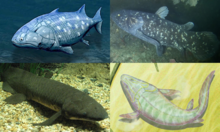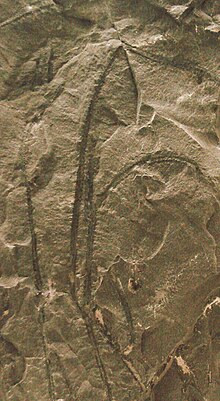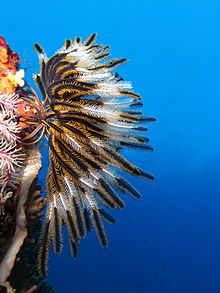Portal:Devonian
The Devonian Portal
The Devonian (/dəˈvoʊni.ən, dɛ-/ də-VOH-nee-ən, deh-) is a geologic period and system of the Paleozoic era during the Phanerozoic eon, spanning 60.3 million years from the end of the preceding Silurian period at 419.2 million years ago (Ma), to the beginning of the succeeding Carboniferous period at 358.9 Ma. It is named after Devon, South West England, where rocks from this period were first studied.
The first significant evolutionary radiation of life on land occurred during the Devonian, as free-sporing land plants (pteridophytes) began to spread across dry land, forming extensive coal forests which covered the continents. By the middle of the Devonian, several groups of vascular plants had evolved leaves and true roots, and by the end of the period the first seed-bearing plants (pteridospermatophytes) appeared. This rapid evolution and colonization process, which had begun during the Silurian, is known as the Silurian-Devonian Terrestrial Revolution. The earliest land animals, predominantly arthropods such as myriapods, arachnids and hexapods, also became well-established early in this period, after beginning their colonization of land at least from the Ordovician period.
Fishes, especially jawed fish, reached substantial diversity during this time, leading the Devonian to often be dubbed the Age of Fishes. The armored placoderms began dominating almost every known aquatic environment. In the oceans, cartilaginous fishes such as primitive sharks became more numerous than in the Silurian and Late Ordovician. Tetrapodomorphs, which include the ancestors of all four-limbed vertebrates (i.e. tetrapods), began diverging from freshwater lobe-finned fish as their more robust and muscled pectoral and pelvic fins gradually evolved into forelimbs and hindlimbs, though they were not fully established for life on land until the Late Carboniferous. (Full article...)
Selected Devonian Article
Sarcopterygii (/ˌsɑːrkɒptəˈrɪdʒi.aɪ/; from Ancient Greek σάρξ (sárx) 'flesh', and πτέρυξ (ptérux) 'wing, fin') — sometimes considered synonymous with Crossopterygii (from Ancient Greek κροσσός (krossós) 'fringe') — is a clade (traditionally a class or subclass) including both a group of bony fish commonly referred to as lobe-finned fish, and tetrapods. They are characterised by prominent muscular limb buds (lobes) within their fins, which are supported by articulated appendicular skeletons. This is in contrast to the other clade of bony fish, the Actinopterygii, which have only skin-covered bony spines supporting the fins.
The tetrapods, a mostly terrestrial superclass of vertebrates, are now recognized as having evolved from sarcopterygian ancestors and are most closely related to lungfishes. Cladistically, this would make the tetrapods a subgroup of Sarcopterygii and thus sarcopterygians themselves. As a result, the phrase "lobe-finned fish" normally refers to not the entire clade but only its members which are not tetrapods.
Non-tetrapod sarcopterygians were once the dominant predators of freshwater ecosystems during the Carboniferous and Permian periods, but suffered significant decline after the Great Dying. The only known extant non-tetrapod sarcopterygians are the two species of coelacanths and six species of lungfishes. (Full article...)List of selected Devonian articles
|
|---|
Selected Devonian land plant article
List of selected Devonian articles
|
|---|
Selected Devonian formation
List of selected Devonian formation articles
|
|---|
Selected Devonian fish article
Selected Devonian invertebrate
Crinoids are marine invertebrates that make up the class Crinoidea. Crinoids that are attached to the sea bottom by a stalk in their juvenile form are commonly called sea lilies, while the unstalked forms, called feather stars or comatulids, are members of the largest crinoid order, Comatulida. Crinoids are echinoderms in the phylum Echinodermata, which also includes the starfish, brittle stars, sea urchins and sea cucumbers. They live in both shallow water and in depths as great as 9,000 meters (30,000 ft).
Adult crinoids are characterised by having the mouth located on the upper surface. This is surrounded by feeding arms, and is linked to a U-shaped gut, with the anus being located on the oral disc near the mouth. Although the basic echinoderm pattern of fivefold symmetry can be recognised, in most crinoids the five arms are subdivided into ten or more. These have feathery pinnules and are spread wide to gather planktonic particles from the water. At some stage in their lives, most crinoids have a short stem used to attach themselves to the substrate, but many live attached only as juveniles and become free-swimming as adults.
There are only about 700 living species of crinoid, but the class was much more abundant and diverse in the past. Some thick limestone beds dating to the mid-Paleozoic era to Jurassic period are almost entirely made up of disarticulated crinoid fragments. (Full article...)List of selected Devonian invertebrates articles
|
|---|
Need help?
Do you have a question about Devonian that you can't find the answer to?
Consider asking it at the Wikipedia reference desk.
Subcategories
Related portals
Associated Wikimedia
The following Wikimedia Foundation sister projects provide more on this subject:
-
Commons
Free media repository -
Wikibooks
Free textbooks and manuals -
Wikidata
Free knowledge base -
Wikinews
Free-content news -
Wikiquote
Collection of quotations -
Wikisource
Free-content library -
Wikiversity
Free learning tools -
Wiktionary
Dictionary and thesaurus




























